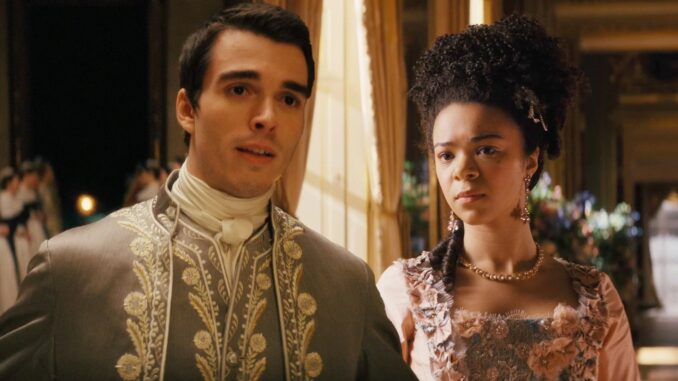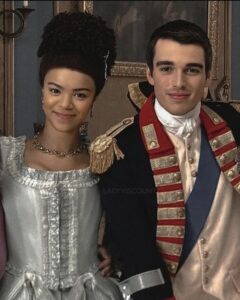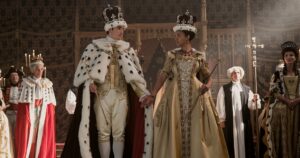
‘Queen Charlotte’ costumer says queen’s outfits have a heartbreaking backstory
Costume designer Lyn Paolo also reveals which character’s costumes were inspired by Prince.
The character Queen Charlotte evolves over the course of her titular show, the first “Bridgerton” spinoff — but thing remains the same through the decades: Charlotte’s fabulous outfits. Played by India Amarteifio and Golda Rosheuvel, Queen Charlotte has a penchant for elaborate hairstyles and ornate gowns (though one could argue her signature accessory is her unimpressed gaze).
Charlotte’s reign begins at the peak of Georgian fashion, which in “Bridgerton”-verse translates to the more formal attire worn by Amarteifio, defined by big ruffles and elaborate underpinnings, including the hooped cages that women wore underneath their petticoats to give their dresses a cylindrical shape.
But by the time period of “Bridgerton,” the characters have moved onto the simple column gowns of the Regency period — except for the queen.

Lyn Paolo, the costume designer for “Queen Charlotte,” explains why to TODAY.com.
“Queen Charlotte was stuck in a moment in time, as some women do in life,” Paolo tell TODAY.com. “Whatever the fashion of their youth was, they stay there.”‘Under a glass dome’
“Queen Charlotte,” while a love story, is a complicated one. Over the course of the show’s six episodes, as she falls more in love with King George III, played by Corey Mylchreest, she slowly understands the severity of his mental illness, which at times, prevents him from even recognizing her.In one scene set in the “Bridgerton” present, Brimsley, the queen’s right-hand man, gives his frank thoughts after Charlotte laments that her children are failing to marry and produce heirs.
“You are still his queen, forever frozen, forever waiting. Your daughters could not leave you here, trapped in time,” he says.
Charlotte’s costumes physically show just how “stuck” she is in her position as queen, Paolo says.
“I felt like she was sort of under a glass dome,” she says. “And she wasn’t able to change for many reasons. That was the happiest time in her life, that was how she felt comfortable.”TikTokers theorize that her costumes are an attempt for Charlotte to help her husband remember her amid his memory loss.
Paolo notes that while the styles of younger and older Charlotte are the same, there is a distinct evolution in the level of regalia, as she took on the full “mantle” of the throne in her husband’s absence.
“In the end, she’s evolved into the epitome of what the queen should be, what the royal family should be,” she says. “And so her gowns get more and more regal as time passes because she has to embody the whole of the royal family because her husband is gone.”
Instead of viewing Charlotte’s life in the “glass dome” as tragic, Paolo describes it as a testament to enduring love.
“Marriage is tricky, and and it doesn’t end on the wedding day,” he says. “I mean, it’s such a beautiful story that these two people have endured through all of the trials and tribulations of their lives. And at the end, you still see that they’re still there. They’re still together. She didn’t go over the wall.”
“I think it resonates with people, the idea that these people have endured,” she adds.

Giving ‘Queen Charlotte’ a distinct lookWhen Paolo stepped up the plate to design the costumes for the “Bridgerton” spinoff, she knew she wanted to continue the fashion tradition established by Ellen Mirojnick, who created the outfits of Seasons One and Two.
“She did this remarkable thing of making the show look so beautiful and so appealing to a modern audience,” Paolo says. “But she was also true to the shape and silhouette of the Regency era.”
But Paolo also wanted to put her “own touch to that world.” One source of inspiration for Paolo was the Met Gala.
Part of her pitch to creator Shonda Rhimes was that gowns would represent a historically accurate silhouette while being glam — so much so that they wouldn’t look out of place on a red carpet today.
“I really kind of want to create like a music video, slash, Met Ball vibe, where you could take the gowns or take the men’s costumes and dress a musician,” she says. “Dress Harry Styles in this and you would think, ‘Oh, yeah, that’s fine. Harry could pull it off.'”
For the men’s costumes, Paolo says they slightly altered the shape of the suit sleeves to be “less pirate like and more Prince.”
“We literally use Prince as our archetype for the men’s costumes,” she adds.
As for differentiating “Queen Charlotte” from “Bridgerton,” Paolo describes the fashion contrast between the two periods as “stark.”
The formal wear of the Georgian period, embodied by Charlotte, was gradually replaced by the Grecian silhouette of the simple column gown, which originated with the court of Marie Antoinette of France, she explains.
“It just shows how much influence the French court had on fashion at the time,” she says.
The signature white muslin gown, often seen in screen adaptations of Jane Austen novels, like 1996’s “Emma,” was considered especially “risqué” for the time period, Paolo says.
“In the sunlight, you could see through it,” she says.
But even “Queen Charlotte” contains influences from the splendor of Marie Antoinette’s fashion, especially through the jewelry. Paolo, a self-proclaimed lover of “all things sparkly,” describes the pieces as part of her unique footprint.
“A lot of the jewels on the show are literally copies of pieces from the period,” she says. “There’s a bracelet is that is a copy of the bracelets that Marie Antoinette wore that were a gift from her husband.”
“Although it doesn’t relate to George and Charlotte, it just shows the decadence of the period,” she adds.
